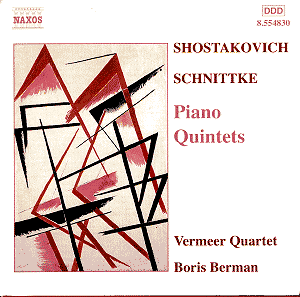Shostakovich and Schnittke shared the distinction and
challenge of being leading Soviet composers. Although a generation or
so apart, both became famous not only for their music, but for the trials
and tribulations of being original, creative minds under a totalitarian
regime which revered or reviled them as the need arose. In spite of
these hardships, both men have left a permanent mark on the musical
world, and we are all the richer for their determination.
The Vermeer Quartet and pianist Boris Berman give us
tour de force performances of chamber music considered to be
high points in the output of each composer. Shostakovich’s piano quintet
from 1940, was a turning point for the composer, whose sixth symphony
had been met with a less than stellar reception the year before. Written
for the Beethoven Quartet and Shostakovich himself, it was programmed
often until ill health forced the composer/pianist to drastically curtail
his performing career. Cast in five movements, this is a beautiful,
lyrical work, full of melodic invention and finesse. Although it is
not short on technical challenges, this music was not designed as a
show of virtuosity. If one had to describe the piece in a single word,
perhaps thoughtful would be the best choice.
Schnittke’s work is quite a contrast to the lyricism
expressed by the older Russian. At times very dense and dissonant, at
others sparse and melancholy, this quintet is also not without its own
moments of sheer beauty. The seamless flow of movements sets up a number
of musical conflicts that are resolved in the pastorale finale. The
piano’s lilting melody is set against a wash of string sound whose slow
harmonic changes and lack of definable rhythmic gestures give the tune
a detached and dreamy quality. At the end the strings drop out, leaving
the piano alone to fade away into the silent distance. This is most
effective writing, leaving the listener almost breathless as the music
disappears.
These are magnificent performances. The sense of balance
and ensemble here is near perfect. Particularly pleasing is the ability
of these musicians to recognize when their individual lines are important
and when in turn to get out of the way of a colleague. These traits
are particularly notable in the Prelude and Fugue of the Shostakovich
work. Throughout the entire program, we are riveted by the group’s phenomenal
ability to catch our ear with an interesting phrase, and then hand us
off to a cohort for something equally fascinating. It takes mere seconds
for the listener to realize that he is in for a great ride as one lovely
turn of phrase cascades into another. This is music-making of the first
order, and repertoire worthy of inclusion in the canon of masterworks
of the genre.
Despite the splendid performances, I would be remiss
were I not to point out two flaws. First is the annoying and pretentious
habit of the Vermeer players to sniff and snort at the beginnings of
phrases. This is something that I find maddening. Stringed instruments
do not require wind to make them play, and it should go without saying
that an ensemble of this quality can be expected to execute a beautiful
phrase. We can hear by the playing that the musicians are "breathing"
with the phrases to make a singing line. The snorts only make me want
to hand out tissues and antihistamines.
The second problem is the program note which is a syntactical
nightmare. The frequent omission of definite articles (the melody appears
"on piano") and the tedious blow-by-blow description of the
music, itself ripe with useless multi-syllabic words, further encourages
the reader to wait for the movie.
In spite of these little bumps in the road, this is
a disc that all lovers of great chamber music should own. Once again
Naxos proves that quality and high price are not synonymous. Recorded
sound it superb. Recommended without reservation.
Kevin Sutton
See also review
by Hubert Culot


